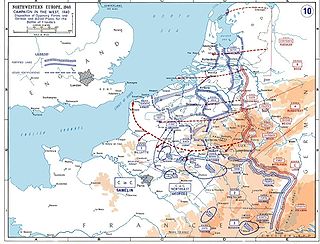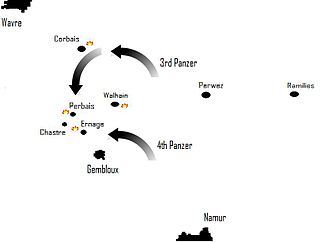 W
WThe invasion of Belgium or Belgian campaign, often referred to within Belgium as the 18 Days' Campaign, formed part of the greater Battle of France, an offensive campaign by Germany during the Second World War. It took place over 18 days in May 1940 and ended with the German occupation of Belgium following the surrender of the Belgian Army.
 W
WThe Battle of the Lys was a major battle between Belgian and German forces during the German Invasion of Belgium of 1940 and the final major battle fought by Belgian troops before their surrender on 28 May. It was the bloodiest of the 18 Days' Campaign. The battle was named after the river Leie, where the battlefield was situated.
 W
WThe Battle of Fort Eben-Emael was a battle between Belgian and German forces that took place between 10 May and 11 May 1940, and was part of the Battle of Belgium and Fall Gelb, the German invasion of the Low Countries and France. An assault force of German paratroopers, Fallschirmjäger, was tasked with assaulting and capturing Fort Eben-Emael, a Belgian fortress whose strategic position and strong artillery emplacements dominated several important bridges over the Albert Canal. These carried roads which led into the Belgian heartland and were what the German forces intended to use to advance. As some of the German airborne forces assaulted the fortress and disabled the garrison and the artillery pieces inside it, others simultaneously captured three bridges over the Canal. Having disabled the fortress, the airborne troops were then ordered to protect the bridges against Belgian counter-attacks until they linked up with ground forces from the German 18th Army.
 W
WThe Dyle Plan or Plan D was the plan of the Commander-in-Chief of the French Army, Général d'armée Maurice Gamelin, to defeat a German attempt to invade France through Belgium. The Dyle (Dijle) river is 86 km (53 mi) long, from Houtain-le-Val through Flemish Brabant and Antwerp; Gamelin intended French, British and Belgian troops to halt a German invasion force along the line of the river. The Franco-Belgian Accord of 1920 had co-ordinated communication and fortification efforts of both armies. The Belgian government let the accord lapse after the German Remilitarization of the Rhineland on 7 March 1936, to adopt a policy of strict neutrality, with the German Army now on the German–Belgian border.
 W
WThe Battle of Gembloux was fought between French and German forces in May 1940 during the Second World War. On 10 May 1940, The Nazi Wehrmacht, invaded Luxembourg, The Netherlands and Belgium under the operational plan Fall Gelb. Allied armies responded with the Dyle Plan, intended to halt the Germans in Belgium, believing it to be the main German thrust. The Allies committed their best and most mobile to an advance into Belgium on 10 May and on 12 May, the Germans began the second part of Fall Gelb, the Manstein Plan an advance through the Ardennes, to reach the English Channel and cut off the Allied forces in Belgium.
 W
WThe Battle of Hannut was a Second World War battle fought during the Battle of Belgium which took place between 12 and 14 May 1940 at Hannut in Belgium. It was the largest tank battle in the campaign. It was also the largest clash of tanks in armoured warfare history at the time.
 W
WThe Battle of Maastricht was one of the first battles that took place during the German Campaign on the Western Front during World War II. Maastricht was a key city in order to capture the Belgian Fort Eben-Emael and split the allied armies in half.
 W
WOperation David was the codename for the deployment of the British Expeditionary Force (BEF) into Belgium at the start of the Battle of Belgium during the Second World War. On the same day as the German invasion of neutral Belgium, 10 May 1940, the BEF moved forward from their prepared defences on the Franco-Belgian border to take up a new position deep inside Belgium, conforming to plans made by the French high command. Forming a defensive line with French and Belgian forces on either side, the BEF were able to contain attacks by German infantry divisions, but were unaware that this was a diversion; the main thrust by highly mobile German armoured divisions was further south. To avoid complete encirclement, the BEF and their allies were forced into a series of fighting retreats and ended up back at their initial border positions by 24 May. However, the German spearhead had reached the coast behind them, cutting them off from their supply chain and leading to the Dunkirk evacuation of the BEF in the following days.
 W
WThe Vinkt massacre was a war crime committed by German soldiers in the villages of Vinkt and Meighem in East Flanders on 26–28 May 1940 during the Battle of the Lys. Between 86 and 140 civilians were deliberately killed by Wehrmacht troops from the 337th Infantry Regiment of the 208th Infantry Division, supposedly in retaliation for the Belgian Army's resistance in the village.